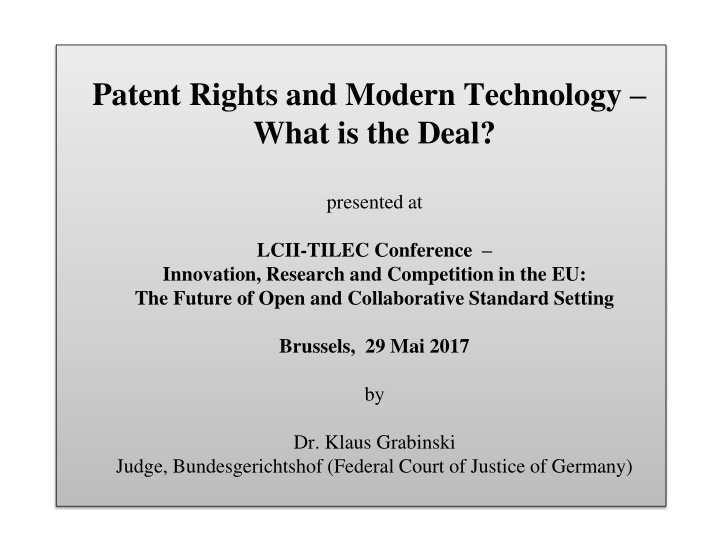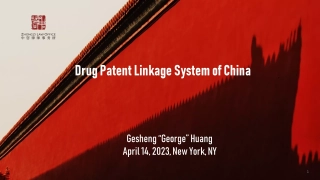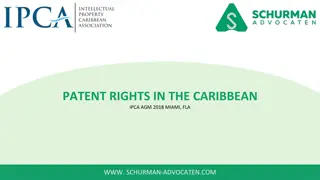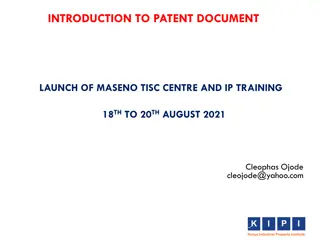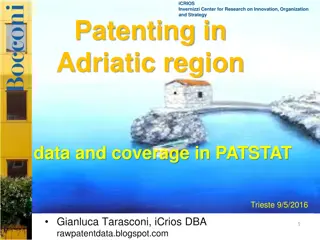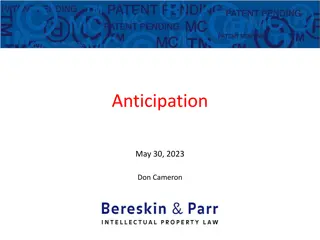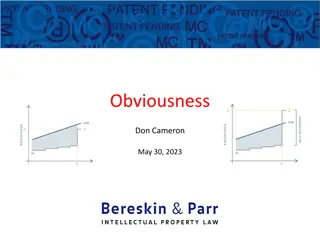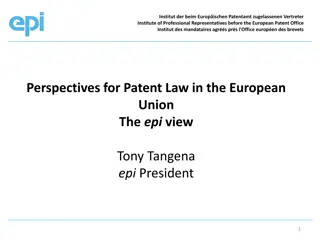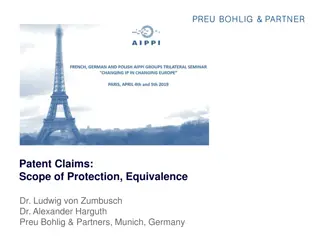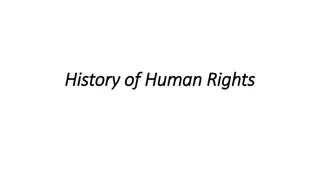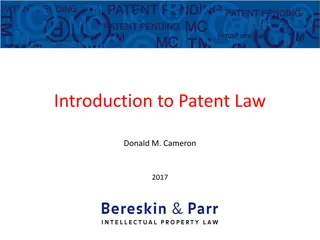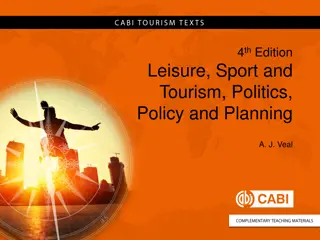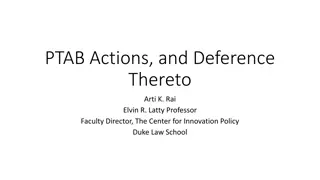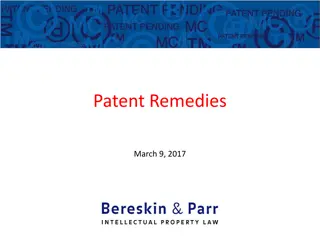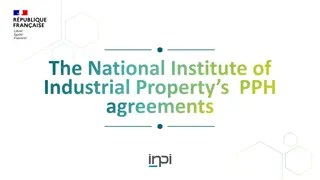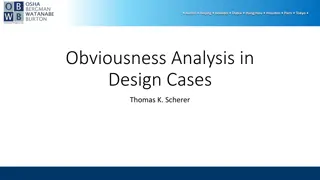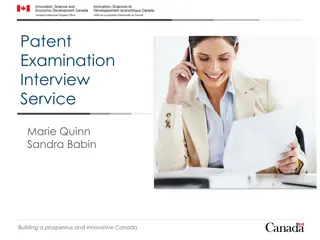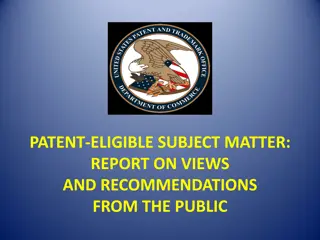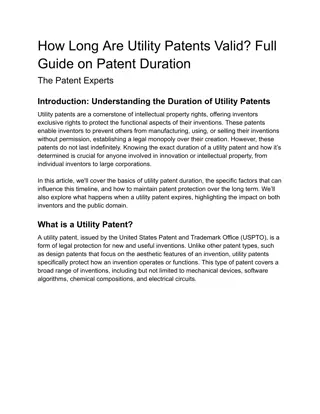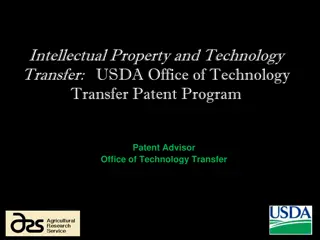Patent Rights and Modern Technology: The Deal Disclosed
Disclosure of patent rights and history, including the inventor's deal with the public, exclusive rights for a limited time, and safeguards in patent applications to ensure innovation and progress in technology.
Download Presentation

Please find below an Image/Link to download the presentation.
The content on the website is provided AS IS for your information and personal use only. It may not be sold, licensed, or shared on other websites without obtaining consent from the author.If you encounter any issues during the download, it is possible that the publisher has removed the file from their server.
You are allowed to download the files provided on this website for personal or commercial use, subject to the condition that they are used lawfully. All files are the property of their respective owners.
The content on the website is provided AS IS for your information and personal use only. It may not be sold, licensed, or shared on other websites without obtaining consent from the author.
E N D
Presentation Transcript
Patent Rights and Modern Technology What is the Deal? presented at LCII-TILEC Conference Innovation, Research and Competition in the EU: The Future of Open and Collaborative Standard Setting Brussels, 29 Mai 2017 by Dr. Klaus Grabinski Judge, Bundesgerichtshof (Federal Court of Justice of Germany)
I. History Disclosure o Patent originates from the Latin patere which means to lay open . o Exclusivity o Patent was a shortened version of letters patent which was a royal decree granting exclusive right to a person. o Technology related o Venetian Patent Statute (1474), Statute of Monopolies (1624) o Limited term o Venetian Patent Statute (1474): 10 years; Statute of Monopolies (1624): 14 years o Patent Rights and Modern Technology - What is the Deal? 2
o Art. 1, Sec. 8 US Constitution (1788): Congress shall have the power to promote the progress of science and useful arts by securing for limited times to authors and inventors the exclusive right to their respective writings and discoveries. o Art. 27 et seq. TRIPS-Agreement (1994): A patent shall confer on its owner the following exclusive rights The term of protection shall not end before the expiration of a period of 20 years counted from the filing date. Patent Rights and Modern Technology - What is the Deal? 3
II. The deal The inventor makes an invention and discloses it to the public. o In return, the patent confers on the inventor (patent owner) the right to exclude others from making use of the invention. o Patent Rights and Modern Technology - What is the Deal? 4
1. Disclosure of the invention to the public Aims at making the invention available to the public and, thus, allowing further technological development. o It has been criticized that patent applicants often try to conceal essential parts of the invention. o However, there are safeguards to make sure that o the invention is new, involve an inventive step and is susceptible of industrial application, patentability as a ground for revocation, art. 138 (1) a) EPC, o the invention is disclosed in a way that it can be carried out, insufficiency as a ground for revocation, art. 138 (1) b) EPC, o the subject-matter of the patent does not extend beyond the content of the application as filed, added matter as a ground for revocation, art. 138 (1) c) EPC. o Patent Rights and Modern Technology - What is the Deal? 5
2. Exclusive right for a limited time Aims at compensating the inventor for making the invention and making it accessible to the public. o Right to exclude others from using the invention within the patent s scope of protection. o Future o injunctive relief, corrective measures, information, etc. o when there is reason to believe that the exclusive right has or will be not respected by a competitor, art. 8, 10 et seq. Directive 2004/48/EC Past o damages, information, legal costs compensation for actual prejudices suffered as a result of patent infringements, art. 8, 13 et seq. Directive 2014/48/EC o Patent Rights and Modern Technology - What is the Deal? 6
III. Does new technology require a new deal? This is mainly discussed with regard to the following aspects: identity of the patent holder, o market situation, o complexity of the product, o public interest. o Patent Rights and Modern Technology - What is the Deal? 7
1. Patent law limitations Exceptions from patentability o commercial exploitation contrary to ordre public , however exploitation shall not be deemed to be so contrary merely because it is prohibited by law or regulation cloning of human beings, use of embryos for industrial or commercial purposes, Art. 6 Directive 98/44/EC, Art. 53 a) EPC; cf. CJEU, 18. Oct. 2011, C-34/10 Green Peace/Br stle, o plant and animal varieties, biological process for the production of plants or animals, Art. 4 Directive 98/44/EC, Art. 53 b) EPC human body, Art. 5 Directive 98/44/EC methods for treatment of the human or animal body by surgery or therapy, Art. 53 c) EPC programs for computers, rules and methods for performing mental acts playing games or doing business as such , Art, 52 (1) c) presentation of information as such , Art. 52 (1) d) Patent Rights and Modern Technology - What is the Deal? 8
Limitations of the effects of a patent, Art. 27 UPCA o acts done for non-commercial purposes acts done for experimental purposes relating to the subject-matter of the invention (Research exemption) use of biological material for the purpose of breeding, or discovering and developing other plant varieties studies, experiments, etc. for obtaining a market authorization for medical products (Bolar exemption), Art. 13 (6) Directive 2001/82/EG and Art. 10 (6) Directive 2991/83/EG the extemporaneous preparation by a pharmacy, for individual cases, of a medicine in accordance with a medical prescription the use of the invention on board of vessels of or in the construction or operation of aircraft or land vehicles or other means of transport of the Paris Union or WTO Patent Rights and Modern Technology - What is the Deal? 9
Compulsory licence o granted by a judicial authority licence seeker has unsuccessfully attempted to obtain a licence from the patent holder the public interest calls for the grant of a compulsory licence, e.g. to make a medicament available on the market with regard to its medical efficacy, reduced harmful side effects, etc. German Federal Patent Court (31 Aug 2016 3 LiQ 1/16) granted a preliminary compulsory licence for Isentress (Raltegravir) which is used as part of a anti-viral therapy of HIV. Decision is appealed. to secure the national infrastructure e.g. in the field of telecommunication, to secure the monetary infrastructure A method to make a bank note not faithfully replicable by scanning-type copying devices, see General Court (5 Sep 2007 T-295/05 DSS/ECB). Patent Rights and Modern Technology - What is the Deal? 10
2. General legal principles o Trips-Agreement, Art. 30 Members may provide limited exceptions to the exclusive rights conferred by a patent, provided that such exceptions do not reasonably conflict with a normal exploitation of the patent and do not unreasonably prejudice the legitimate interests of the patent owner, taking account of the legitimate interests of third parties. o Enforcement Directive 2004/48/EC, Art. 3 (1) and (2): Measures, procedures and remedies shall be fair and equitable , effective, proportionate and dissuasive to be applied in such a manner as to avoid the creation of barriers to legitimate trade and to provide for safeguards against their abuse Patent Rights and Modern Technology - What is the Deal? 11
o Injunctive relief available for Non-Practicing Entities? US Supreme Court in eBay/MercExchange, 4-Factor-Test: irreparable injury suffered by plaintiff remedies available at law are inadequate balance of hardship between the parties public interest would not be disserved by a permanent injunction 4-Factor-Test transferable from US law to EU law? different legal system US: weighing equitable factors whether an injunction should be issued; EU: injunction results from a patent as an exclusive right fee shifting rather a rule in the EU and rather an exception in the US contingency fees much more popular in the US than in the EU patents over business methods and computer programs as such available under US law but not under EPC Provisional injunctive relief for NPEs? Patent Rights and Modern Technology - What is the Deal? 12
o Small component of a complex product Opinion of Justice Kennedy in eBay/MercExchange [2006]: When the patented invention is but a small component of the products the companies seek to produce and the threat of an injunction is employed simply for undue leverage in negotiations, legal damage may well be sufficient to compensate for the infringement and an injunction may not serve the interest of the public. UK courts (e.g. J. Pumfrey in Navitaire/EasyJet [2006], para 101; confirmed by LJ. Jacob in Virgin Atlantic/Premium Aircraft [2009], para 23 and J. Arnold in HTC/Nokia [2013], para 32) if the effect of the grant of an injunction is not oppressive the defendant cannot buy his way out of it, even if the price, objectively ascertained, would be modest. My understanding of the word oppressive in this context is that the effect of the grant of the injunction would be grossly disproportionate to the right protected. Patent Rights and Modern Technology - What is the Deal? 13
Bundesgerichtshof (Federal Court of Justice) W rmetauscher (Heat exchanger) [2016]: The grant of a grace period in a patent infringement litigation is only justifiable if due to special circumstances the impact of an immediate enforcement of injunctive relief would result in a disproportionate hardship for the infringer which goes far beyond the regular consequences of an enforcement of an exclusive right and, therefore, would have to be considered to be an abuse of right. In the case-at-hand, where the duration of the patent elapsed only about 6 months after the rendition of the judgement, the Court did not assume such special circumstances. Defendant s heating exchanger was not an essential component since the general usability of the vehicle was left unaffected. Defendant s did not show a willingness to enter into license negotiations. Patent Rights and Modern Technology - What is the Deal? 14
3. Competition law CJEU, 16 July 2015 C-170/13 - Huawei/ZTE: The exercise of an exclusive IP right cannot in itself constitute an abuse of a dominant position. o However, the exercise of an IP right may, in exceptional circum- stances, involve abusive conduct for the purposes of Art. 102 TFEU. o The holder of an SEP who has given an irrevocable FRAND untertaking does not abuse its dominant position by seeking injunctive relief for infringement of the SEP as long as it observes certain requirements: o SEP holder must alert SEP user. SEP holder has to make a specific offer when SEP user states willingness. SEP user must respond, promptly submit counter-offer and, when refused by SEP holder, provide security and render account. SEP user may challenge validity, essentiality or use of the SEP. Patent Rights and Modern Technology - What is the Deal? 15
National courts are currently struggling with issues like: What are the requirements of an offer or a counter-offer. o How should security be calculated? o What is the basis for the determination of FRAND? o Portfolio: All standards or only standard to which the SEP belongs? Territory: Worldwide, Europe-wide or national? How to determine FRAND? o License as if the SEP were a Non-SEP? What if offer and counter-offer are FRAND? o Is the distributor allowed to refer the SEP holder to the manufacturer/importer of the product as a willing licensee? o In case of transfer, does the FRAND undertaking travel with the SEP? o Patent Rights and Modern Technology - What is the Deal? 16
IV. Result The idea of giving limited-in-time protection for an invention that has been disclosed to the public by its inventor remains to be well-founded and has not become old fashioned. However, modern technology as well as the public interest, the concept of free market, new business models and other overlap situations may require certain adjustments. Law-makers, pubic authorities, academics, lawyers, stakeholders and courts are struggling to find balanced concepts for each of these situations. The discussion will remain to be interesting for a long time. Patent Rights and Modern Technology - What is the Deal? 17
Thank you very much for your attention! Patent Rights and Modern Technology - What is the Deal? 18
